Spitfire Mk.Vb Floatplane Conversion Set
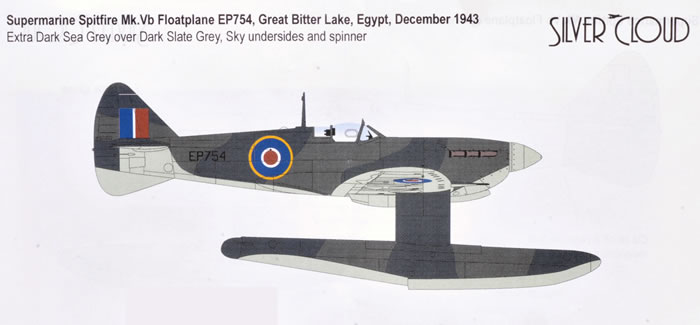
Silver Cloud, 1/48 scale
S u m m a r y : |
Catalogue Number and Description |
Silver Cloud Item No. SCC4801 - Supermarine Spitfire Mk.Vb Conversion Set |
Price: |
£18.00 plus postage available online from Freightdog Models |
Scale: |
1/48 scale |
Contents & Media: |
16 parts in grey resin; instructions. |
Review Type: |
First Look. |
Advantages: |
Excellent casting; crisp and consistent surface detail; very interesting variation. |
Disadvantages: |
No decals or beaching gear. |
Conclusion: |
Silver Cloud's 1/48 scale Spitfire floatplane conversion is an excellent conversion that only requires two cuts to the kit parts along panel lines. This one will be suitable for anyone who has worked with resin before.
Highly recommended. |
Reviewed by Brett Green

HyperScale is proudly supported by Squadron.com
With the German invasion of Norway in April 1940, the RAF took an interest in the concept of using floatplane fighters in areas where airfields were not immediately available. To this end a Spitfire Mk I R6722 was taken in hand at the Woolston factory to be modified and mounted on Blackburn Roc floats. Tank tests were carried out at Farnborough, using a 1/7 scale model, it was found that the concept was basically sound, although the vertical tail surfaces would need to be enlarged to counterbalance the side area of the floats. The end of the Battle of Norway and the need for as many Spitfires as possible meant that R6772 was converted back to an ordinary fighter without being flown.
With the entry of Japan into the war the concept was revived in early 1942. A Spitfire V W3760 was fitted with a pair of floats 25 ft 7 in (7.8 m) long, mounted on cantilever legs. This aircraft was powered by a Merlin 45 driving a four-bladed propeller of 11 ft 3 in (3.43 m) diameter (3.4 m). A Vokes filter was fitted to the carburettor air intake and under the tail an extra fin extension was added. Other changes included external lifting points forward of and behind the cockpit and a spin-recovery parachute with a rudder balance-horn guard.
The Spitfire floatplane was first flown on 12 October 1942 by Jeffrey Quill. Soon afterwards the Vokes filter was replaced by an Aero-Vee filter, similar to that on later Merlin 61 series aircraft, which was extended to prevent water entry, and full Mk VB armament was installed. Two more VBs EP751 and EP754 were converted by Folland and all three floatplanes were transported to Egypt, arriving in October 1943.

At the time it was thought that the floatplanes could operate from concealed bases in the Dodecanese Islands, disrupting supply lines to German outposts in the area which relied on resupply by transport aircraft. This scheme came to naught when a large number of German troops, backed by the Luftwaffe, took over the British held islands of Kos and Leros. No other role could be found for the floatplane Spitfires, which languished in Egypt, operating from the Great Bitter Lake.
Specifications for the VB based floatplane included a maximum speed of 324 mph (521 km/h) at 19,500 ft (521 km/h at 5,943 m), a maximum rate of climb of 2,450 ft/min at 15,500 ft (12.45 m/s at 4,724 m) and an estimated service ceiling of 33,400 ft (10,180 m).
In the spring of 1944, with the prospect of use in the Pacific Theatre, a Spitfire IX MJ892 was converted to a floatplane. This used the same components as the earlier Mk VB conversions. Jeffrey Quill wrote:
"The Spitfire IX on floats was faster than the standard Hurricane. Its handling on the water was extremely good and its only unusual feature was a tendency to "tramp" from side to side on the floats, or to "waddle" a bit when at high speed in the plane."
Soon after testing started the idea of using floatplane fighters was dropped and MJ982 was converted back to a landplane.
Five aircraft were converted:
-
Mk I - R6722
-
F Mk Vb - W3760
-
Mk V - EP751 and EP754
-
Mk IXb - MJ892 *
As far as I am aware, this is the only Spitfire floatplane conversion available in 1/48 scale.
Silver Cloud's 1/48 scale Supermarine Spitfire Vb Floatplane Conversion comprises just 16 parts in grey resin. This is designed for the excellent new Airfix Spitfire Mk.Vb, kit no. A05125.
The focus of the conversion is the floats, which are cast in one piece each. The casting strip and fine strip of flash will be very easy to clean up, and casting quality is perfect on my sample.
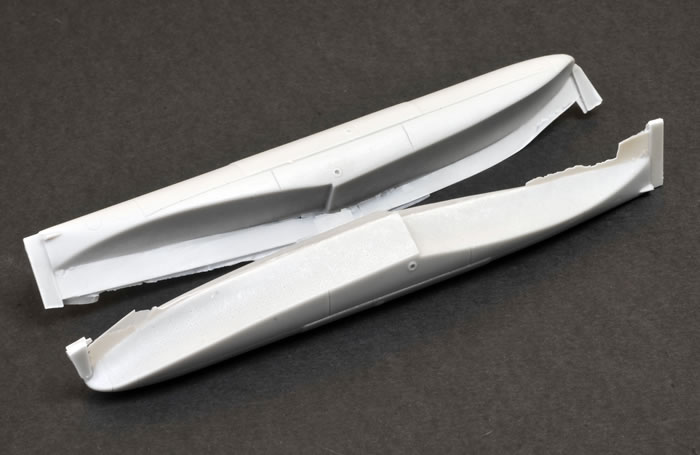
Crisp recessed panel lines plus some overlapping panels and raised detail all look great.
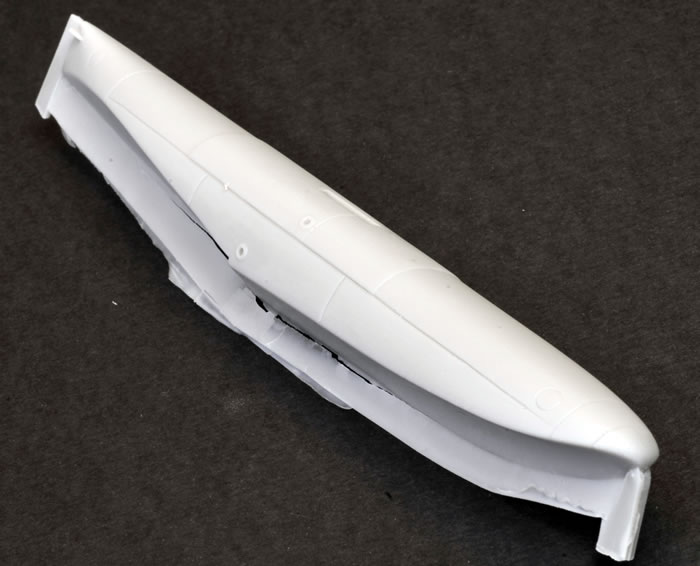
The supports are cast with long locating slots at the bottom to fit in the top of the floats. A smaller capsule-shaped tab is located at the top of the supports, designed to fit in a correspinding recess in the wheel well blanks. Due to the size and relative weight of the floats, I'll be drilling and pinning the upper and lower support joins for a bit of extra insurance.
The large tail with its new ventral fin is supplied as a single resin part with a separate rudder. This will require the removal of the kit's tail from the diagonal empennage panel line - a single cut on each side of the kit's fuselage. This is the only surgery to kit parts required in the entire conversion.
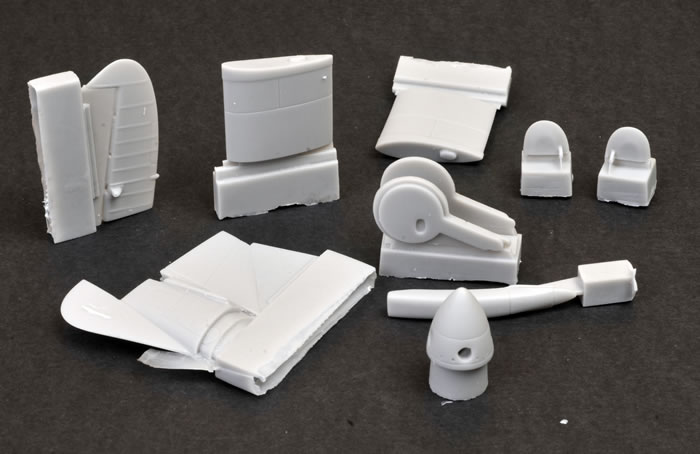
The aforementioned wheel well blanks are simply glued to the inside of the bottom wing half before the wings are assembled.
The other resin parts are the float rudders, the long carburettor fairing, new four-bladed spinner and the four propeller blades.
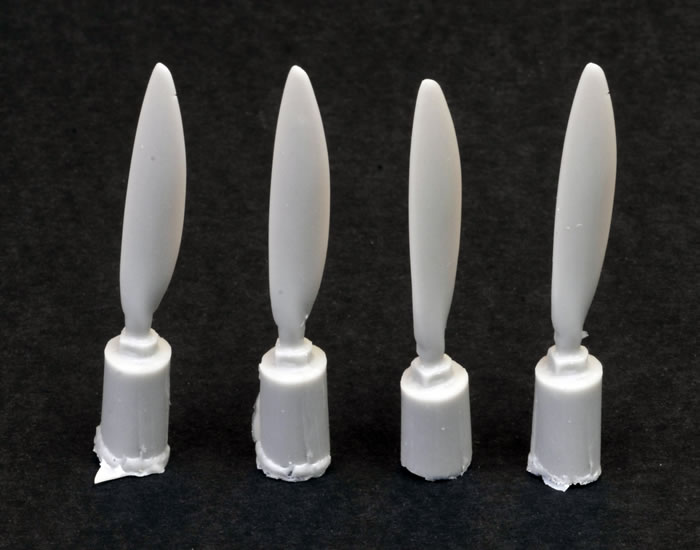
Instructions and colour callouts are offered on a double-sided A4 sheet with helpful drawings and notes.
Decals are not supplied, but they only comprise the roundels, fin flash and black serial number. If you are considering this conversion, you probably have a well-equipped decal spares box anyhow!
I did think it was a shame that beaching gear was not included though. Maybe we'll see an aftermarket offering in the future.
Silver Cloud's 1/48 scale Spitfire floatplane conversion is an excellent conversion that only requires two cuts to the kit parts along panel lines. This one will be suitable for anyone who has worked with resin before.
Highly recommended.
* Historical summary from Wikipedia
Thanks to Colin from Freightdog Models for the Preview information and images
Freightdog Models and Decals are available online fron their website |
